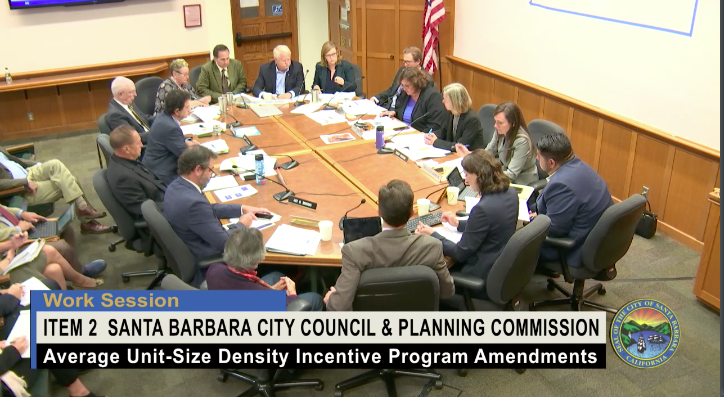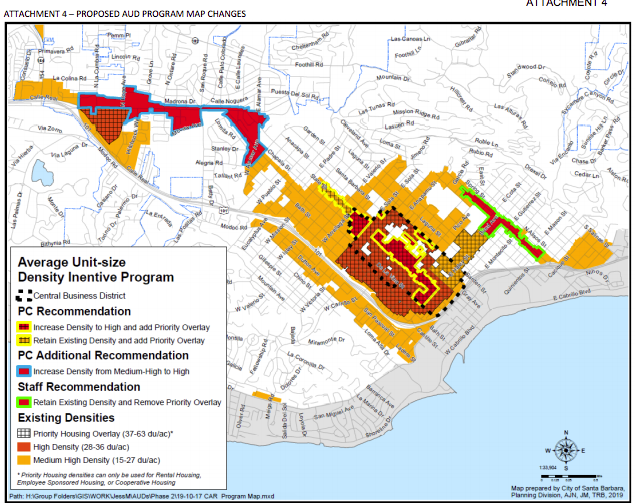City Council Votes to Build Housing Downtown
Increasingly Vacant State Street Will House Renters, Attract Shoppers

The City of Santa Barbara has gone to great lengths to save its downtown from becoming a ghost town. After years of trial and error, the City Council killed two birds with one stone Thursday.
The Council unanimously voted to allow more rental units in the heart of the Central Business District, a move that will both chip away at the housing crisis and simultaneously help revitalize the dying downtown businesses.
The vote was one of several conceptual votes the Council took at its joint meeting with the Planning Commission on proposed amendments to the city’s experimental rental housing program. The votes came after the Planning Commission spent over 10 hours preparing the whopping 22 recommended changes, detailed here.
The program, known as the Average Unit-size Density (AUD) program, was approved in 2013 as a way to incentivize developers to build more housing by allowing greater building density for rental apartments after the city spent 40 years with few to none built at all. The AUD program has an initial duration of eight years or until 250 new units are constructed. It’s currently six years in, and more than 225 new units have been built.
“Once we make the decision [to add high-density housing to downtown], we won’t know if it’ll actually work,” Councilmember Eric Friedman said. “We had unintended consequences with AUD, and if we have them here, we will have little recourse but to accept the consequences.”
The unintended consequences Friedman referenced are the rental costs. Although AUD has been successful with creating rentals, they so far are market-rate and unaffordable, defeating the purpose of the program. For example, the 2019 citywide median rate for a studio apartment is $1,540 a month, but the studios at Arlington Village (an AUD project) currently run for $2,507 a month.
The City Council recently passed a 10 percent inclusionary housing requirement for high-density projects to prevent this in future developments, but more reform is needed. The cost of land in the Central Business District — where the council voted to allow priority AUD housing — is the highest in the city.
The council also voted to remove the priority-housing in the Milpas Corridor, where land costs are much cheaper, but the loss of AUD developments would theoretically be accounted for by adding them into the downtown area. Staff suggested removing AUD projects from Milpas because of safety concerns with overdevelopment in the area and worries that large rental developments would ruin the old neighborhood charm and character.

Many public commenters voiced fear that removing priority housing on Milpas could gentrify the largely low-income area, particularly because it will incentivize developers to build condos and other larger, more luxury developments without the push to build AUD rentals. Councilmember Jason Dominguez, who represents Milpas and the greater Eastside neighborhood, disagreed.
“This is actually startling to me,” Dominguez said. “Since when did townhomes and condos become gentrification? … We are creating downmarket products for residents and then not allowing them to enter the middle class. We should want them to buy the property they live in; that’s central to the American dream.”
Although the Planning Commission was split on the issue at past meetings, most of the council agreed with Dominguez, and they approved it 5-2, with Mayor Cathy Murillo and Councilmember Friedman voting to keep it.
“I’m a no because it’s a major transportation corridor and rentals make sense there,” Murillo said. “There are bike lanes, the Cota bike lane, and you can easily walk from Milpas to Downtown.”
The most radical idea was to not require any residential parking, potentially spurring residents to forgo a vehicle and use public transportation. The proposal would allow developers to pay an in-lieu fee rather than build parking in the downtown district, because downtown buildings are built lot line to lot line, making it difficult to create parking.
Parking spaces are also expensive for developers at an average of $40,000 a space, so the in-lieu fee would encourage them to build more units because they’d only pay the city $10,000 a space instead of actually building them. The council also moved it forward, although it will come back at a later time for more discussion and tweaking because the meeting was conceptual.
Carrie Kelly, the executive director of the Downtown Santa Barbara Organization, supported the push to not build parking spaces, which many cited as infeasible for families who might want to live downtown.
“I am married and a mom of a 3-year-old daughter, and we would be happy to forgo a car to live downtown, especially being the director of the organization,” Kelly said. “Santa Barbara has many public transportation opportunities.”
The other parking amendments were barely discussed by the council, although the Planning Commission spent hours on them. Unbundled parking, which means tenants would have an option to rent their parking space separately from their units, was unanimously approved by the council without any discussion. They only approved unbundled parking in the Central Business District, not city-wide, which they discussed at greater length.
The members also favored prohibiting new tenants from participating in the residential parking program city-wide, meaning that they won’t be given a residential parking permit to park in the areas of the city that only allow drivers 75 minutes to park.
The council was unable to get through the rest of the proposed amendments in its four-hour meeting, but will continue through at an undecided later date.




You must be logged in to post a comment.